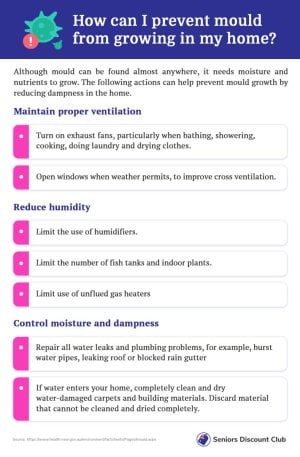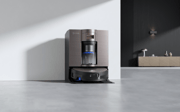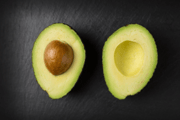Professional organiser reveals the ‘secret’ DIY spray that completely transformed a mouldy bathroom cabinet!
- Replies 2
Isn't it ironic that the very places we clean ourselves can become a haven for mould and mildew? Whether it be the shower tiles, bathroom cabinet or even occasionally our favourite leather jacket, mould seems to find a way to assert its unwelcome presence.
We've all been there. One minute you're marvelling at your squeaky-clean bathroom, the next, you're staring down a mini ecosystem of mould colonies trying to establish their territory in your cabinet.
But fear not, dear members, we have a solution here for you!
Professional organiser, Anita Birges, has been dealing with this exact mould predicament, and she shared the whole process in a video, to which she captioned: 'You asked for it! You got it! And it could not have come at a better time, as it's been about a year since I last cleaned out this bathroom cabinet…and guess what was lurking in there? MOULD.'
Brace yourself for the unveiling of a homemade spray that transformed her mouldy bathroom cabinet back to its former glory.
First and foremost, Ms Birges decluttered the cabinet, removing all items and making space to wage war against the mouldy invaders.
Following that, she concocted a mixture of half isopropyl alcohol (also known as rubbing alcohol) and half warm water, using this to clean the mildew-infested area. With a trusty microfibre cloth, she wiped down the surface, saying her goodbyes to the unwelcome guests.

Then came her secret weapon: the DIY mould prevention spray, comprising of 100ml of vinegar, 10 drops of tea tree oil, and 10 drops of clove oil. Each ingredient adds its unique touch to the mixture; the vinegar, with its acidity, obliterates the mould spores; the tea tree oil, with its anti-microbial properties, braces for future attacks, and the clove oil attacks the spores head-on with its anti-fungal prowess.
With the spray loaded and ready to go, she evenly spritzed it across the entire cabinet surface, letting it air-dry without wiping it. This allows the oils and vinegar to sit on the surface and continually combat any residual spores.
To keep the mould away, Birges suggests using this DIY spray on other surfaces too. In the shower, for example, simply spray the solution on your tiles, give it a good scrub and leave it for 20 minutes before rinsing off.
Miraculously, you will see the mould between your tiles disappear and be kept at bay for the foreseeable future, courtesy of this clever concoction.
She’s also employed her cleaning regimen on far more diverse items like vertical blinds and even a leather jacket!
Following a similar method to the bathroom cabinet clean-up, she scrubbed the mould off with the isopropyl alcohol and water mix, then sprayed the anti-mould solution.
If you ever feel that cleaning your bathroom, especially the hard-to-reach corners and crevices, is overwhelming, take solace in the fact that there are ways to tackle the problem efficiently with simple household items.
According to NSW Health, mould can be found virtually everywhere, both indoors and outdoors. It reproduces using spores which can cause health problems if inhaled by people who are sensitive or allergic to them. In serious cases, it can cause a severe mould infection, usually in the lungs.

Those with asthma, allergies, or other breathing conditions may be especially sensitive to mould, as well as people with weakened immune systems or chronic lung diseases.
So, dear members, ready your vinegar, essential oils, and rubbing alcohol. It's the dawn of battle, and it's time to reclaim your bathroom, your sanctuary from the clutches of mould colonies. After all, cleanliness might seem like a chore, but a sparkling bathroom– now that's priceless.
Do you prefer using at-home solutions for tackling mould and mildew or do you have a favourite cleaning product? Share your thoughts and suggestions with us in the comments!
We've all been there. One minute you're marvelling at your squeaky-clean bathroom, the next, you're staring down a mini ecosystem of mould colonies trying to establish their territory in your cabinet.
But fear not, dear members, we have a solution here for you!
Professional organiser, Anita Birges, has been dealing with this exact mould predicament, and she shared the whole process in a video, to which she captioned: 'You asked for it! You got it! And it could not have come at a better time, as it's been about a year since I last cleaned out this bathroom cabinet…and guess what was lurking in there? MOULD.'
Brace yourself for the unveiling of a homemade spray that transformed her mouldy bathroom cabinet back to its former glory.
First and foremost, Ms Birges decluttered the cabinet, removing all items and making space to wage war against the mouldy invaders.
Following that, she concocted a mixture of half isopropyl alcohol (also known as rubbing alcohol) and half warm water, using this to clean the mildew-infested area. With a trusty microfibre cloth, she wiped down the surface, saying her goodbyes to the unwelcome guests.

Use these simple tips from NSW Health to keep mould at bay. Source: NSW Health / Seniors Discount Club
Then came her secret weapon: the DIY mould prevention spray, comprising of 100ml of vinegar, 10 drops of tea tree oil, and 10 drops of clove oil. Each ingredient adds its unique touch to the mixture; the vinegar, with its acidity, obliterates the mould spores; the tea tree oil, with its anti-microbial properties, braces for future attacks, and the clove oil attacks the spores head-on with its anti-fungal prowess.
With the spray loaded and ready to go, she evenly spritzed it across the entire cabinet surface, letting it air-dry without wiping it. This allows the oils and vinegar to sit on the surface and continually combat any residual spores.
To keep the mould away, Birges suggests using this DIY spray on other surfaces too. In the shower, for example, simply spray the solution on your tiles, give it a good scrub and leave it for 20 minutes before rinsing off.
Miraculously, you will see the mould between your tiles disappear and be kept at bay for the foreseeable future, courtesy of this clever concoction.
She’s also employed her cleaning regimen on far more diverse items like vertical blinds and even a leather jacket!
Following a similar method to the bathroom cabinet clean-up, she scrubbed the mould off with the isopropyl alcohol and water mix, then sprayed the anti-mould solution.
If you ever feel that cleaning your bathroom, especially the hard-to-reach corners and crevices, is overwhelming, take solace in the fact that there are ways to tackle the problem efficiently with simple household items.
According to NSW Health, mould can be found virtually everywhere, both indoors and outdoors. It reproduces using spores which can cause health problems if inhaled by people who are sensitive or allergic to them. In serious cases, it can cause a severe mould infection, usually in the lungs.
Key Takeaways
- A professional organiser, Ms Birges, shared a video on how she tackles a mouldy bathroom cabinet using DIY spray.
- She cleaned the mildew using a half-and-half solution of isopropyl alcohol and warm water, wiping it off with a microfibre cloth.
- After cleaning, she used a DIY mould prevention spray made from 100ml of vinegar, 10 drops of tea tree oil and 10 drops of clove oil.
- This DIY procedure not only maintains cleanliness but also prevents the return of mould, and it can be used on other surfaces.
Those with asthma, allergies, or other breathing conditions may be especially sensitive to mould, as well as people with weakened immune systems or chronic lung diseases.
So, dear members, ready your vinegar, essential oils, and rubbing alcohol. It's the dawn of battle, and it's time to reclaim your bathroom, your sanctuary from the clutches of mould colonies. After all, cleanliness might seem like a chore, but a sparkling bathroom– now that's priceless.
Do you prefer using at-home solutions for tackling mould and mildew or do you have a favourite cleaning product? Share your thoughts and suggestions with us in the comments!







